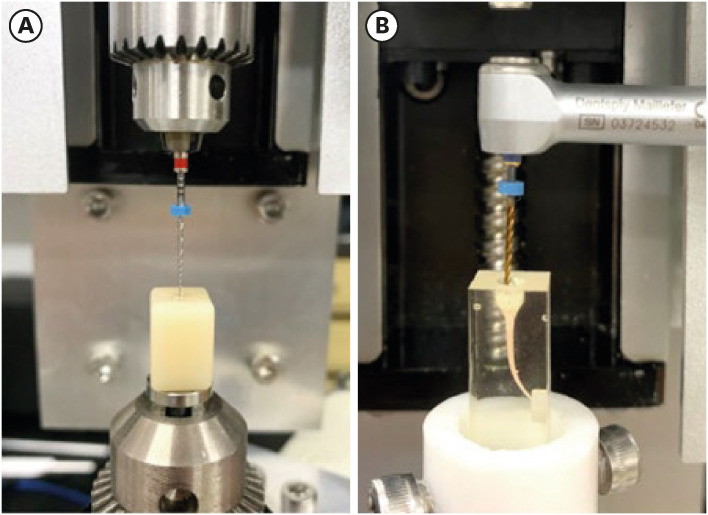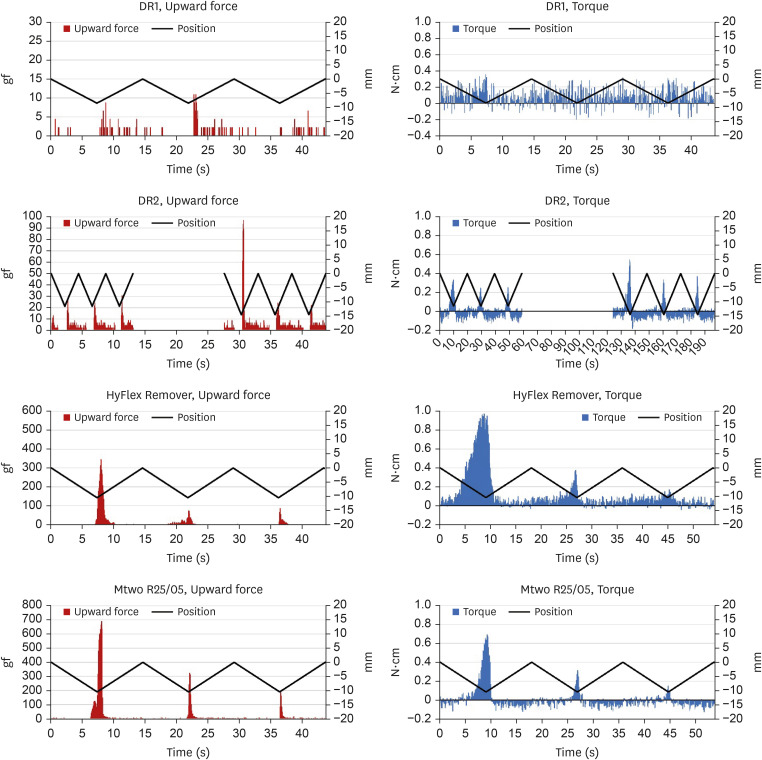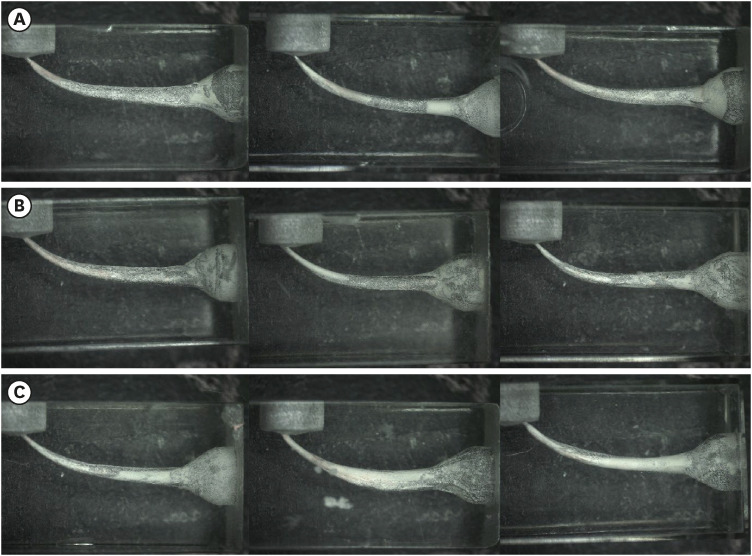Restor Dent Endod.
2023 Feb;48(1):e10. 10.5395/rde.2023.48.e10.
Buckling resistance, torque, and force generation during retreatment with D-RaCe, HyFlex Remover, and Mtwo retreatment files
- Affiliations
-
- 1Gwangjin Ye Dental Clinic, Seoul, Korea
- 2Department of Conservative Dentistry, Kyung Hee University Medical Center, Kyung Hee University College of Dentistry, Seoul, Korea
- KMID: 2548167
- DOI: http://doi.org/10.5395/rde.2023.48.e10
Abstract
Objectives
This study compared the buckling resistance of 3 nickel-titanium (NiTi) retreatment file systems and the torque/force generated during retreatment.
Materials and Methods
The buckling resistance was compared among the D-RaCe (DR2), HyFlex Remover, and Mtwo R25/05 retreatment systems. J-shaped canals within resin blocks were prepared with ProTaper NEXT X3 and obturated by the single-cone technique with AH Plus. After 4 weeks, 4 mm of gutta-percha in the coronal aspect was removed with GatesGlidden drills. Retreatment was then performed using DR1 (size 30, 10% taper) followed by DR2 (size 25, 4% taper), HyFlex Remover (size 30, 7% taper), or Mtrwo R25/05 (size 25, 5% taper) (15 specimens in each group). Further apical preparation was performed with WaveOne Gold Primary. The clockwise torque and upward force generated during retreatment were recorded. After retreatment, resin blocks were examined using stereomicroscopy, and the percentage of residual filling material in the canal area was calculated. Data were analyzed using 1-way analysis of variance with the Tukey test.
Results
The HyFlex Remover files exhibited the greatest buckling resistance (p < 0.05), followed by the Mtwo R25/05. The HyFlex Remover and Mtwo R25/05 files generated the highest maximum clockwise torque and upward force, respectively (p < 0.05). The DR1 and DR2 files generated the least upward force and torque (p < 0.05). The percentage of residual filling material after retreatment was not significantly different between file systems (p > 0.05).
Conclusions
NiTi retreatment instruments with higher buckling resistance generated greater clockwise torque and upward force.
Figure
Reference
-
1. Karamifar K, Mehrasa N, Pardis P, Saghiri MA. Cleanliness of canal walls following gutta-percha removal with hand files, RaCe and RaCe plus XP-Endo Finisher instruments: a photographic in vitro analysis. Iran Endod J. 2017; 12:242–247. PMID: 28512494.2. Topçuoğlu HS, Aktı A, Tuncay Ö, Dinçer AN, Düzgün S, Topçuoğlu G. Evaluation of debris extruded apically during the removal of root canal filling material using ProTaper, D-RaCe, and R-Endo rotary nickel-titanium retreatment instruments and hand files. J Endod. 2014; 40:2066–2069. PMID: 25443282.
Article3. Beer FP, Johnston ER, DeWolf JT. Mechanics of materials (in SI units). New York, NY: McGraw-Hill Education;2004.4. Thompson SA. An overview of nickel-titanium alloys used in dentistry. Int Endod J. 2000; 33:297–310. PMID: 11307203.
Article5. Zupanc J, Vahdat-Pajouh N, Schäfer E. New thermomechanically treated NiTi alloys - a review. Int Endod J. 2018; 51:1088–1103. PMID: 29574784.
Article6. Rödig T, Hausdörfer T, Konietschke F, Dullin C, Hahn W, Hülsmann M. Efficacy of D-RaCe and ProTaper Universal Retreatment NiTi instruments and hand files in removing gutta-percha from curved root canals - a micro-computed tomography study. Int Endod J. 2012; 45:580–589. PMID: 22264204.
Article7. Garg A, Nagpal A, Shetty S, Kumar S, Singh KK, Garg A. Comparison of time required by D-RaCe, R-Endo and Mtwo instruments for retreatment: an in vitro study. J Clin Diagn Res. 2015; 9:ZC47–ZC49.8. Staffoli S, Grande NM, Plotino G, Özyürek T, Gündoğar M, Fortunato L, Polimeni A. Influence of environmental temperature, heat-treatment and design on the cyclic fatigue resistance of three generations of a single-file nickel-titanium rotary instrument. Odontology. 2019; 107:301–307. PMID: 30483996.
Article9. Kwak SW, Shen Y, Liu H, Kim HC, Haapasalo M. Torque generation of the endodontic instruments: a narrative review. Materials (Basel). 2022; 15:664. PMID: 35057383.
Article10. Ha JH, Cheung GS, Versluis A, Lee CJ, Kwak SW, Kim HC. ‘Screw-in’ tendency of rotary nickel-titanium files due to design geometry. Int Endod J. 2015; 48:666–672. PMID: 25088359.
Article11. Ha JH, Park SS. Influence of glide path on the screw-in effect and torque of nickel-titanium rotary files in simulated resin root canals. Restor Dent Endod. 2012; 37:215–219. PMID: 23429968.
Article12. Yilmaz A, Helvacioglu-Yigit D, Gur C, Ersev H, Kiziltas Sendur G, Avcu E, Baydemir C, Abbott PV. Evaluation of dentin defect formation during retreatment with hand and rotary instruments: a micro-CT study. Scanning. 2017; 2017:4868603. PMID: 29109814.
Article13. Htun PH, Ebihara A, Maki K, Kimura S, Nishijo M, Tokita D, Okiji T. Comparison of torque, force generation and canal shaping ability between manual and nickel-titanium glide path instruments in rotary and optimum glide path motion. Odontology. 2020; 108:188–193. PMID: 31506734.
Article14. Lopes HP, Elias CN, Siqueira JF Jr, Soares RG, Souza LC, Oliveira JC, Lopes WS, Mangelli M. Mechanical behavior of pathfinding endodontic instruments. J Endod. 2012; 38:1417–1421. PMID: 22980191.
Article15. FKG Dentaire: D-Race. updated June 1, 2010. cited November 1, 2021. Available from: https://www.fkg.ch/products/endodontics/retreatment/d-race.16. Coltene: HyFlex Remover. updated October 1, 2019. cited November 1, 2021. Available from: https://japan.coltene.com/products/endodontics/retreatment-files/retreatment-files//hyflex-remover/.17. VDW: VDW dental Mtwo user brochure. updated December 20, 2015. cited November 1, 2021. Available from: https://www.vdw-dental.com/fileadmin/Dokumente/Sortiment/Aufbereitung/Rotierende-Aufbereitung/Mtwo/VDW-Dental-Mtwo-User-Brochure-EN.pdf.18. Fukumori Y, Nishijyo M, Tokita D, Miyara K, Ebihara A, Okiji T. Comparative analysis of mechanical properties of differently tapered nickeltitanium endodontic rotary instruments. Dent Mater J. 2018; 37:667–674. PMID: 29731488.
Article19. Kwak SW, Ha JH, Cheung GS, Kim SK, Kim HC. Comparison of in vitro torque generation during instrumentation with adaptive versus continuous movement. J Endod. 2019; 45:803–807. PMID: 30935617.
Article20. Lopes WS, Vieira VT, Silva EJ, Silva MC, Alves FR, Lopes HP, Pires FR. Bending, buckling and torsional resistance of rotary and reciprocating glide path instruments. Int Endod J. 2020; 53:1689–1695. PMID: 32767775.
Article21. Oh S, Jeon BK, Chang SW. Mechanical properties and torque/force generation of XP-Endo Shaper, Trunatomy, Spring Endo File, and Spring Endo heated finish file, part 1. Appl Sci. 2022; 12:10393.
Article22. Hülsmann M, Drebenstedt S, Holscher C. Shaping and filling root canals during root canal re-treatment. Endod Topics. 2008; 19:74–124.
Article23. Piazza B, Rivera-Peña ME, Alcalde MP, de Vasconcelos BC, Duarte MA, de Moraes IG, Vivan RR. The Influence of humidity on intra-tubular penetration and bond strength of AH Plus and MTA Fillapex: an in vitro study. Eur Endod J. 2017; 3:48–54. PMID: 32161855.
- Full Text Links
- Actions
-
Cited
- CITED
-
- Close
- Share
- Similar articles
-
- Efficacy of retreatment NiTi files for root canals filled with calcium silicate-based sealer
- Incidence of apical crack formation and propagation during removal of root canal filling materials with different engine driven nickel-titanium instruments
- A new post removal technique using ATD tugging device
- Micro-computed tomographic evaluation of canal retreatments performed by undergraduate students using different techniques
- Effect of size and taper on the mechanical properties of profile and Hyflex CM Ni-Ti endodontic files





